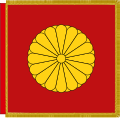| Imperial Seal of Japan | |
|---|---|
 | |
| Armiger | Naruhito, Emperor of Japan |
| Order(s) | Order of the Chrysanthemum |
The Imperial Seal of Japan or National Seal of Japan, also called the Chrysanthemum Seal (菊紋, kikumon), Chrysanthemum Flower Seal (菊花紋, 菊花紋章, kikukamon, kikukamonshō) or Imperial chrysanthemum emblem (菊の御紋, kikunogomon), is the mon used by the Emperor of Japan and members of the Imperial Family.
It is one of the national seals of Japan and is used in a manner similar to a national coat of arms of Japan, e.g., on Japanese passports. The Japanese government uses a different emblem, the Paulownia seal.
History
During the Meiji period (1868–1912), no one was permitted to use the Imperial Seal except the Emperor of Japan, who used a 16-petalled chrysanthemum with sixteen tips of another row of petals showing behind the first row. Therefore, each member of the Imperial family used a slightly modified version of the seal. Shinto shrines either displayed the imperial seal or incorporated elements of the seal into their own tag.
Earlier in Japanese history, when Emperor Go-Daigo, who tried to break the power of the shogunate in 1333, was exiled, he adopted the seventeen-petalled chrysanthemum in order to differentiate himself from the Northern Court's Emperor Kōgon, who kept the imperial 16-petalled mon.
Description
The symbol is a yellow or orange chrysanthemum with black or red outlines and background. A central disc is surrounded by a front set of 16 petals. A rear set of 16 petals are half staggered in relation to the front set and are visible at the edges of the flower. An example of the chrysanthemum being used is in the badge for the Order of the Chrysanthemum.
Other members of the Imperial Family use a version with 14 single petals, while a form with 16 single petals is used for orders, passports, Diet members' pins, and other items that carry or represent the authority of the Emperor. The Imperial Seal is also used on the standards of the Imperial Family.
Gallery
-
Imperial seal emblazoned on the cover of a Japanese passport
-
 Imperial Throne of the Emperor of Japan
Imperial Throne of the Emperor of Japan
-
Emblazoned on the doors of a tomb in Kyōtanabe, Kyoto
-
 Bow of the battleship Mikasa
Bow of the battleship Mikasa
-
 Imperial Seal on an Order of the Garter banner when the Emperor is a member of the Order
Imperial Seal on an Order of the Garter banner when the Emperor is a member of the Order
-
 Imperial Seal in Heraldischer Atlas (1899)
Imperial Seal in Heraldischer Atlas (1899)
-
Miyajima postage stamp (1939)
See also
- National seals of Japan
- Chrysanthemum Throne
- Imperial Seal of Korea
- Imperial Seal of Manchukuo
- Order of the Chrysanthemum
- Mon (emblem)
References
- "皇室儀制令(1926(Taisho Era 15)皇室令第7号)" (in Japanese). Archived from the original on August 9, 2007.
External links
 Media related to Imperial seals of Japan at Wikimedia Commons
Media related to Imperial seals of Japan at Wikimedia Commons
| Japan articles | |||||||||||||
|---|---|---|---|---|---|---|---|---|---|---|---|---|---|
| History |
| ||||||||||||
| Geography | |||||||||||||
| Politics |
| ||||||||||||
| Economy | |||||||||||||
| Society | |||||||||||||
| Armorial of Asia | |
|---|---|
| Sovereign states |
|
| States with limited recognition | |
| Dependencies and other territories | |
